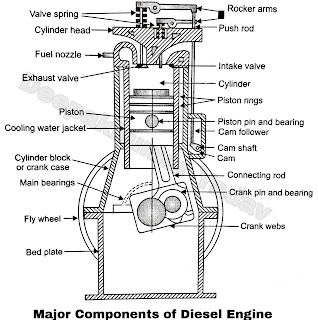Diesel Engine Parts and its Function
Q. How does a diesel engine work?
Q. What is diesel engine system?
Q. What are the main parts of a diesel engine?
Q. What are main parts of engine?
Q. Diesel Engine Components and Their Functional Applications
Q. What is the Construction of diesel engine
To understand the working of diesel engine, we should know the main parts of diesel engine and the functions of each part. Figure A represents the main wanting components of Compression Ignition, four stroke ode diesel engine.
The main parts are as listed below :
(a) Cylinder.
(b) Cylinder head.
(c) Piston and piston rings.
(d) Connecting rod.
(e) Crank shaft and crank webs.
(f) Main bearing.
(g) Crank in and beaning.
(h) Nozzle.
(i) Piston pin and bearing.
(j) Exhaust valve.
(k) Cam Part.
(l) Valve springs.
(m) Cylinder block or crankcase.
(n) Fly wheel.
(o) Bed plate.
(p) Cooling water jackets.
(b) Cylinder head : It close one end of the cylinder and usually contains the valves which admit the air and and fuel and discharge the exhaust gases.
(c) Piston and piston rings : Piston closes the other end of the working space of the cylinder. It transmits the power developed by burning of fuel to the crank shaft. In the distance travelled by it form one end of cylinder to the other is termed as stroke. The piston rings lubricated with engine oil produced gas-tight seal between the piston and the cylinder liner.
(d) Connecting rod : The function of the connecting rod is to change and transmit the reciprocating motion of the piston to the continuously rotating crank pin during the working stroke and vice-versa during other strokes. The small end of it is attached to the wrist pin located in the piston and the other end i.e. big end has a bearing for the crank pin.
(e) Crank shaft : It transmits the power from piston to the driven shaft. The parts of the crankshaft supported by and rotating in the main bearing are called as journals. It runs under the action of the piston through the connecting rod and crank pin located between crank webs or checks.
(f) Main bearing : The main bearings support the crankshaft and the crank shaft is turning In these main bearings.
(g) Crank pin and bearing : This is a bearing between the big end of the connecting rod and crank pin.
( h) Nozzle : The fuel injection system consists of a fuel pump, fuel line and the fuel injector. Fuel is delivered into the combustion space of the cylinder by an Injection system. The Injector also called as fuel injection nozzle or spray nozzle delivers fuel in the form of fine spray under pressure through small hole.
(i) Piston pin and bearing : Piston pin and bearing connects the piston with connecting rod , to make it possible to move the piston in the cylinder
(j) Exhaust valve : The products of combustion after doing work on the piston are removed from cylinder via this valve.
(k) Cam shaft : It is driven from the crank shaft by a timing gear on a chain. It operates the intake valve and the exhaust valve through the cam, cam followers, push rods and rocker arms.
(l) Valve springs : Valve springs serve to dose the valve.
(m) Cylinder block or crank case : The crank case holds together the cylinder, piston and crankshaft. It is also called as cylinder block if the cylinder liners are inserted into it.
(n) Fly wheels : Fly wheels are used to take care of fluctuations of the cyclic variations in the speed. It stores energy during the power stroke and releases it during other strokes, giving nearly constant output torque.
(o) Bed plate : The lower portion of the crank case which is bolted to the foundation is called the bed plate.
(p) Cooling water jackets : The cooling water enters the jackets in the cylinder head which is comparatively hot and passes on to the jackets for the cylinder. Its purpose is to keep the combustion space walls cool.
